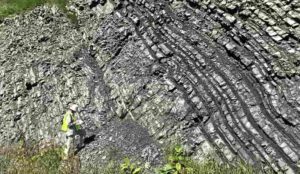
One of Earth’s greatest mysteries is how it transformed itself, ever so gradually, from a barren ball of rock into a launching pad for life.
Earth scientists have spent decades piecing together the relevant clues—identifying and studying the planet’s complex interplay of geological processes, atmospheric dynamics, and chemical cycles. In particular, scientists have studied the roles played by carbon and silicon in stabilizing Earth’s climate over a vast stretch of time.
Now a Yale-led study in the journal Nature provides an unprecedented look at this 3-billion-year-old story, told in ancient sediments from around the world.
“We wanted to advance our understanding of what processes have regulated Earth’s climate over geologic time scales,” said Noah Planavsky, an associate professor of Earth and planetary sciences in Yale’s Faculty of Arts and Sciences and co-corresponding author of the new study with Yale graduate student Boriana Kalderon-Asael and University College London researcher Philip Pogge von Strandmann.
“How the Earth’s climate has remained stable for the majority of the last 3 billion years is one of the most fundamental questions one can ask about how the Earth works,” Planavsky said.
At the root of Earth’s climate life story is its ability to remove carbon dioxide from the atmosphere and store it in rocks and sediments. We have plants to thank for that, the researchers said.
The emergence of plants on land and in the ocean led to gradual—but major—changes in how rocks and sediments weathered. These changes in weathering opened the door for sequestering carbon into the Earth itself.
“The result was a substantial decrease in carbon dioxide levels, which kept pace with the increasing luminosity of the sun as it aged, helping to ensure that the Earth remained persistently habitable to both simple and complex life forms,” Planavsky said.
Kalderon-Asael and Planavsky led an international team of researchers that gathered more than 600 sediment samples at roughly 100 sites worldwide. The researchers studied geochemical data found in lithium isotopes in the samples—a methodology used in other studies over the past decade to look at specific points in Earth’s recent and distant past.
The new study encompasses the entirety of Earth’s history, allowing researchers to document the evolution of how Earth regulated its climate.
“It gives us the whole picture,” said Kalderon-Asael, the study’s first author. “This began as a one-year project to look at a couple of sites. As we started to see the data come in, we added more collaborators and more samples until we were able to look at all of Earth’s history.”
In addition to the history lesson, the study offers a long-term perspective on the rapid changes in global climate today.
“Through all of the massive changes Earth has undergone—in the biosphere and in the amount of solar radiation it receives—it has remained habitable by making adjustments on extremely long time-scales,” Planavsky said. “It highlights how totally unprecedented the current shifts are in the carbon cycle.”
Reference:
Boriana Kalderon-Asael et al, A lithium-isotope perspective on the evolution of carbon and silicon cycles, Nature (2021). DOI: 10.1038/s41586-021-03612-1
Note: The above post is reprinted from materials provided by Yale University.










